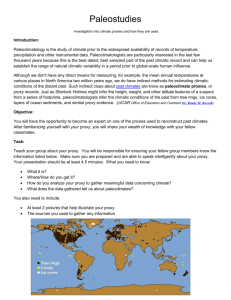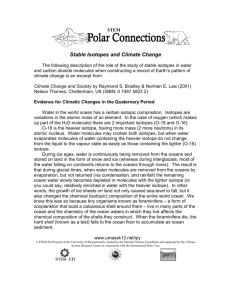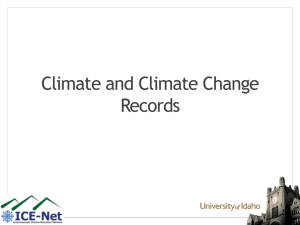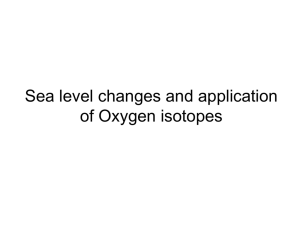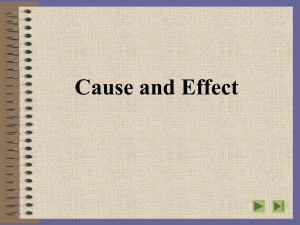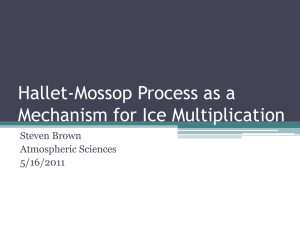Climate Proxies
advertisement
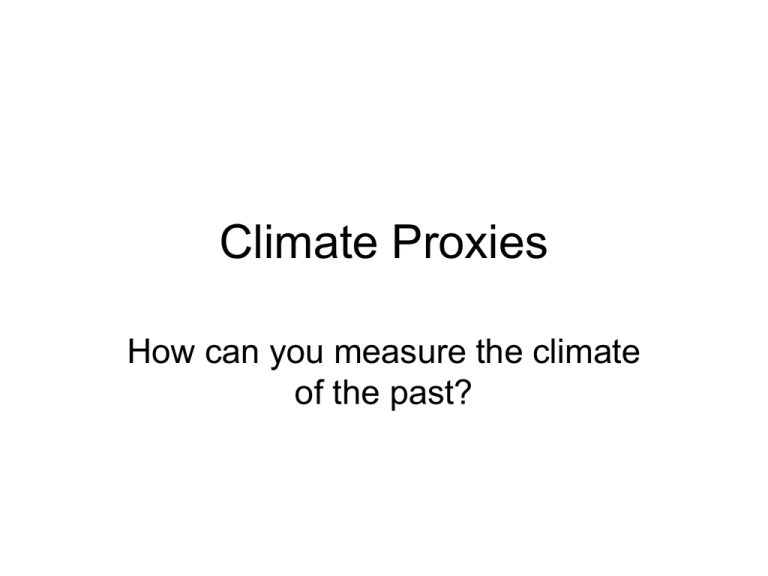
Climate Proxies How can you measure the climate of the past? Learner outcomes At the end of this lecture you should be able to 1. Describe how proxies differ from observations 2. Describe how tree rings, corals, fossils, lake ice and lake duration are used to estimate local climate 3. Describe how ocean sediment and ice cores are used to estimate global climate 4. The difference between stable and radiometric isotopes and what type of information they tell use about past climates Proxies Unlike instrumental records that tell us only about the most recent century, proxy records (natural archives of climate change) enable us to place recent climatic change in the context of the last several hundred to thousand years. 1000 Years of CO2 and Global Warming Temperature (Northern Hemisphere) CO2 Concentrations How do we develop proxies? • Assumptions • Observations of phenomenon today • Link current observations to past records Assumptions • Observation: Solar radiation varies but overall decreases • Therefore solar radiation in the past was higher Proxies • Corals* • Tree rings* • Pollen* • Fossils* • Sea level • Lake ice duration* • Ocean sediments • Ice Cores *indicative more of local climate change than global climate change Corals • Shells made of Calcium Carbonate (CaCO3) • Shell in equilibrium with the ocean water • Band width provided evidence of temperature the coral grew in • Growth rates change with ocean temperatures, pH levels • Local climate Why should we hug trees? • Dendrochronology is the study of the annual variability of tree ring widths, which can be extended back to 8000 years ago. • The study of trees provides climate information regarding temperature, runoff, precipitation, and soil moisture. • Local climate Date of last ring is year tree was cut 1930 1890 1870 1910 1950 1970 Tree Rings Growth conditions recorded in rings • Wide ring-warm days sufficient water • Narrow-cold days/drought What can plant and animal fossils tell us about ancient climates? These 350 Ma fossil ferns were most likely the oldest on land, and likely required high pCO2 levels. A trilobite, the three- lobed king of warm, shallow Cambrian seas • Certain plants and animals live only in specific environments, so their presence is a clue to local climate. Soft-bodied Waptia, an arthropod from the Cambrian Burgess Shale Lake Monona Ice Duration 1855-2005 180 Duration of Ice (days) 160 140 120 100 80 60 40 20 0 1855 1875 1895 1915 1935 Seasons Source: Wisconsin State Climatology Office 1955 1975 1995 Examples of Climate Proxies • Pollen • Tree Rings • Ice Cores Lake Ice Duration Lake Ice Thickness Global Proxies • Sea level • Ocean sediment • Ice cores – Layers (varves) in ice cores – Gases in ice cores – Stable Isotopes: O-16 to O-18 ratio in ice cores – Radiometric Isotopes:Carbon dating of sediment in the ice cores or glacial deposits Sea Level • Glaciation –low sea level Ocean Sediment Cores: 3-3.5km • Thick levels of sedimentation can indicate heavy weathering, warmer temperatures • Volcanic sediments • Loss of sediment layers through erosion • 55 mya Frozen Core Some cores go 3 km deep! • Vostok, Antarctica 78°28' S, 106°48'E: Coldest Places on Earth Vostok Station Nationality: Russia Location: Vostok - an outpost if there ever was one - is located near the The coldest South Geomagnetic Pole, at the center recorded of the East Antarctic ice sheet, where temperature on the flux in the earth's electromagnetic Earth, -128.6°F (field is manifested. 89.2°C) was measured here on July 21, 1983. Ice core drilling 3.4 km to go ½ million years into past climate Ice Cores: Varves • A varve is an annual layer of sediment or sedimentary rock Section of Greenland Cores Dozen Ice Ages going back 1 billion years How can ancient greenhouse gases be trapped? • Atmospheric gases (CO2, CH4, SO2, etc.) can be trapped in glaciers as frozen water metamorphoses from snow to firn to recrystallized ice. During the Last Glacial Maximum pCO2 is estimated at 180 ppm The record of atmosphere CO2 since the Industrial Revolution Ice Core Thermometer Isotopes • Stable Isotopes-temperature • Radiometric dating-rate and date How can oxygen isotopes used as paleoclimate proxies? • isotope -- atoms of the same element with the same atomic number (chemical properties) but differing atomic weight (physical properties). Differ in number of neutrons. • Oxygen is composed mostly of 16O and 18O, which as part of water molecules are separated by physical processes. A typical carbon atom with 6 protons and 6 neutrons and 6 electrons. Fractionation • To divide or separate into parts • Ocean water is made up of both O-16 and O-18 There is a standard or average ratio of O-18 to O-16 (standard mean ocean water as the baseline, SMOW) • Certain physical and biological processes change the ratio (this is fractionation) Oxygen Isotopic Ratios or Amounts O18/O16 ratio in glacial ice indicate the atmosphere temperature in which the snow that made up the ice formed Extent of isotopic difference (fractionation) is dependent on the temperature. So they form a temperature proxy! Oxygen Isotopic Ratios vs. Amounts O18/O16 ratio versus O-18 and O-16 Usually described as a ratio Oxygen Fractionation Summary • If ratio O-18 to O-16 is higher than expected in the ocean, colder temperatures • If ratio O-18 to O-16 is lower than expected in the ocean, warmer temperatures Oxygen Isotopes in Glacier Ice • Polar ice is preferentially enriched with O16 relative to the ocean (O-16 locked in glacier ice). So especially during glaciation ocean water is “heavy” • Why is glacier ice “light”? – The water source is from precipitation which is preferentially light. • So during a glaciation you would expect remaining ocean water to be heavy Radiometric Isotopes • Isotopes that decay (Carbon) can tell us the approximate date of an event or the rate at which an event took place – Glacial retreat Carbon Dating: Rate of Glacial Retreat Greenland Ice Sheet and Arctic: Northern Hemisphere Antarctica: South Pole

